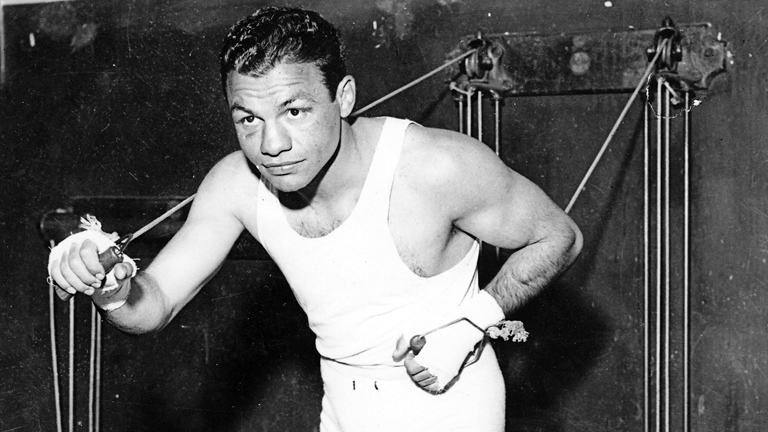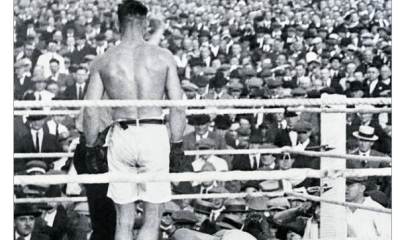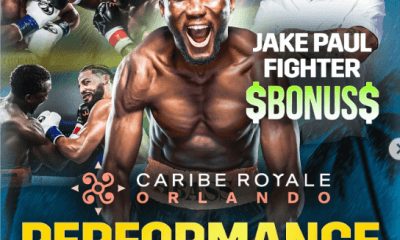Asia & Oceania
Tony Canzoneri Tops the List of the Top 10 Fighters from New Orleans
Regis Prograis is widely considered the alpha male in the 140-pound division, a weight class bursting with talented fighters who seemingly haven’t yet reached their peak.

Regis Prograis is widely considered the alpha male in the 140-pound division, a weight class bursting with talented fighters who seemingly haven’t yet reached their peak. Prograis risks his “interim” title on July 14 against Juan Jose Velasco, and although Velasco, a 31-year-old Argentine, is undefeated (20-0), the match is considered little more than a tune-up for “Rougarou” who is on a collision course with former U.S. Olympian Jose Carlos Ramirez, the WBO belt-holder.
Prograis vs. Velasco will be held at New Orleans Lakefront Arena, and that is a story in itself. Although New Orleans has a great boxing tradition, there hasn’t been a prizefight in the Crescent City worthy of more than a footnote since 2006.
A New Orleans native, Regis Prograis took up boxing in New Orleans just before the great exodus wrought by Hurricane Katrina. Although he too was uprooted by the storm, he maintains a strong emotional attachment to the city of his birth. And if he keeps winning, he will assuredly come to be remembered among the best boxers ever produced by America’s most exotic city.
Here’s how this reporter ranks the top fighters from New Orleans:
Tony Canzoneri 1925-1939 (141-24-10, 44 KOs)
Born in Slidell, Louisiana, Canzoneri lived in New Orleans from the age of two until the age of thirteen when the family moved to Brooklyn. He came to the fore in Brooklyn (only five of his 175 fights were held in New Orleans), but by most accounts he was still living in the Crescent City when he acquired the rudiments of the sweet science. During his career, he won the New York State version of the featherweight title, captured world titles at 130 and 140 before these weight classes achieved wide acceptance, and ruled as the undisputed king of the lightweights. At his peak, circa 1931, he was generally considered the top pound-for-pound fighter in the sport.
Harry Wills 1911-1932 (71-9-3, 57 KOs)
Standing 6-foot-2 and customarily carrying 210 pounds on his well-muscled frame, Wills, the Black Panther, was 12-2-2 in documented fights with legendary Sam Langford, and never mind that Langford, nine years older, had a lot of wear and tear when Wills caught up with him. Denied the opportunity to fight Jack Dempsey because of his pigmentation, Wills lost status late in his career when he suffered back-to-back defeats to future Joe Louis opponents Jack Sharkey and Paulino Uzcudun, but no other fighter in his pod won more fights that were billed for the world’s colored heavyweight title.
Pete Herman 1912-1922 (61-13-8, 20 KOs)
Herman, born Peter Culotta, unseated the formidable Kid Williams to win the world bantamweight title in 1917. Late in his career he stopped British boxing superhero Jimmy Wilde in the 17th frame, turning the trick at London’s Prince Albert Hall before a hostile crowd that included the Prince of Wales. Herman was going blind when he left the sport at the age of twenty-six. In retirement he ran a popular black-and-tan club in the upper French Quarter, the district in which he was born.
Joe Brown 1941-1970 (120-47-14, 55 KOs)
Brown was a throwback, a man whose career harked to the days of Harry Wills. “Old Bones” had 107 bouts under his belt when he wrested the world lightweight title from Wallace “Bud” Smith in New Orleans in 1956. Although something of a cutie, he could adapt if drawn into a slugfest. The ninth of his 11 successful title defenses, against England’s Dave Charmley in London, was the 1961 The Ring magazine Fight of the Year.
Jack Everhardt 1892-1905, 1908 (30-4-13, 21 KOs)
Born and bred in the Crescent City, Everhardt answered the bell for 656 rounds, an average of almost 14 rounds per start. In his 11th pro fight, he stopped England’s Stanton Abbott in the 24th round of 25-round contest to earn recognition as the Lightweight Champion of the South. In 1896, he boxed two draws with the immortal Kid Griffo and engaged in a fierce fight with George Lavigne, the renowned Saginaw Kid. The bout ended in Lavigne’s favor in the 24th frame.
Freddie Little 1957-1972 (51-6, 31 KOs)
Little wasn’t actually from New Orleans, but from nearby Picayune, Mississippi. However, he attended New Orleans’ Dillard University, made his pro debut in New Orleans and had 13 early fights here before relocating to Las Vegas where he had a day job as an elementary schoolteacher. Little briefly held the unified (WBA and WBC) 154-pound world title, losing the belt in Italy in a 15-round fight with Carmelo Bossi, a bout in which the referee docked him four points for mysterious infractions.
Tony Licata 1969-1980 (60-7-4, 26 KOs)
Half-Italian and half-Chinese, Licata, a New Orleans native, spent 44 weeks in The Ring’s top 10, rising to #1 which earned him a crack at Carlos Monzon’s world middleweight title. Licata wasn’t in Monzon’s league; the Argentine, in his lone appearance on U.S. soil, stopped Licata in the 10th frame at Madison Square Garden. But no middleweight in the world was in Monzon’s league at that point in Monzon’s career.
Bernard Docusen 1943-1953 (74-10-6, 22 KOs)
The best of three fighting brothers, born in New Orleans to a Filipino father and a French Creole mother, Docusen was the top-rated welterweight in The Ring rankings when he met the defending champion, Sugar Ray Robinson, at Comiskey Park, the home of the Chicago White Sox, in 1948. Docusen faded after 10 frames, but was still standing at the final bell.
Joe Mandot 1909-1921 (52-18-12, 13 KOs)
Mandot was never a champion, but in his heyday he was as popular among the locals as Pete Herman. A lightweight competing in an era in which the division was very strong, the New Orleans Baker Boy (his father owned a bakery) defeated such notables as Owen Moran, Ad Wolgast, and Johnny Kilbane, and was 2-1 in three spirited 20-round bouts with Mexican Joe Rivers. When the cheering stopped, he battled depression. His body was fished out of a New Orleans bayou in 1956, a presumptive suicide.
Willie Pastrano 1951-1965 (62-13-8, 14 KOs)
This low placement will strike many people as nuts. After all, Pastrano, a stylish fighter who purportedly taught Muhammad Ali a few of his subtle moves, is enshrined in the Boxing Hall of Fame. But Pastrano, whose career was an exercise in perseverance – he won the world light heavyweight title in his 76th pro bout – came along at the right time and was the beneficiary of two awful decisions, his title winning effort against Harold Johnson and the gift draw he received against ancient Archie Moore.
Honorable Mentions (listed alphabetically)
Andy Bowen (1890-1894): Who knows how good Bowen might have been if he had come along in a different era? A stocky café-au-lait lightweight with avid followers on both sides of the racial divide, Bowen’s fight with Texas Jack Burke at New Orleans’ Olympic Club in 1893 lasted over seven hours, the longest uninterrupted prizefight ever on American soil. Nineteen months later he was dead, the victim of a ring fatality. Knocked out in the 18th round by Kid Lavigne, Bowen hit his head on the hard ring floor (there was no felt under the canvas) as he fell. He died the next day without regaining consciousness.
Martin Burke (1919-1929): Burke, a light heavyweight, victorious in 52 of 87 fights, made his pro debut on his 19th birthday in a 15-round contest that was called after seven rounds because of rain. Late in his career he was knocked out twice in the opening round by Young Stribling in suspicious fights but prior to that he went the distance with Gene Tunney, Harry Greb, and Tommy Loughran, five fights in all consuming 57 rounds. (Some readers will remember his son, actor Paul Burke, whose credits included the leading role in the award-winning TV police drama The Naked City.)
Maxie Docusen (1944-1954): “Little Duke” finished his career with a record of 76-6-3, but although he had a better winning percentage than his older brother, he wasn’t as talented. His signature win was a 12-round decision over fan favorite Enrique Bolanos at LA’s fabled Olympic Auditorium in a bout billed for the California State Lightweight Title. Bolanos won the rematch.
Ralph Dupas (1950-1966): A stablemate of Willie Pastrano (they were born six weeks apart), Dupas wasn’t quite 15 years old when he made his pro debut. Late in his career, he lifted the world 154-pound title from unified champion Denny Moyer, winning a 15-round split decision. Dupas, who finished with a record of 106-23-6, answering the bell for 1135 rounds, had his last five fights at the Fremont Hotel in downtown Las Vegas where he was breaking in as a blackjack dealer. When his speech became too slurred to keep his job, he returned to New Orleans to live out his days.
John Duplessis (1984-1995): Duplessis brought a 36-1 record into his 1991 140-pound title fight with the great Julio Cesar Chavez. A competitive showing would have nudged him into the Top 10, but it was a stroll in the park for El Gran Campeon who shooed him away in the fourth round.
Eddie Flynn (1930-1935): Flynn, 29-7-2 as a pro, was actually from Tampa where he eventually set up shop after graduating from the School of Dentistry at New Orleans’ Tulane University. Flynn was a student at Tulane with nine pro fights under his belt when he won the gold medal in the welterweight class at the 1932 Olympics.
Jimmy Perrin (1933-1941): An alternate on the 1932 U.S. Olympic team, Perrin, born James LaCava, was 52-8-7 (10 KOs) as a pro. He fought almost exclusively in New Orleans where he scored his signature win in 1940, a 15-round decision over Irish Bobby Ruffin in a bout stamped as a world featherweight title fight by the Louisiana Boxing Commission. After leaving the sport, he served 20 years on the New Orleans police force.
Check out more boxing news on video at The Boxing Channel
-

 Featured Articles4 weeks ago
Featured Articles4 weeks agoThe Hauser Report: Cinematic and Literary Notes
-

 Book Review3 weeks ago
Book Review3 weeks agoMark Kriegel’s New Book About Mike Tyson is a Must-Read
-

 Featured Articles2 weeks ago
Featured Articles2 weeks agoThe Hauser Report: Debunking Two Myths and Other Notes
-

 Featured Articles3 weeks ago
Featured Articles3 weeks agoMoses Itauma Continues his Rapid Rise; Steamrolls Dillian Whyte in Riyadh
-

 Featured Articles4 weeks ago
Featured Articles4 weeks agoTop Rank Boxing is in Limbo, but that Hasn’t Benched Robert Garcia’s Up-and-Comers
-

 Featured Articles3 weeks ago
Featured Articles3 weeks agoKotari and Urakawa – Two Fatalities on the Same Card in Japan: Boxing’s Darkest Day
-

 Featured Articles2 weeks ago
Featured Articles2 weeks agoNikita Tszyu and Australia’s Short-Lived Boxing Renaissance
-

 Featured Articles2 weeks ago
Featured Articles2 weeks agoIs Moses Itauma the Next Mike Tyson?



















